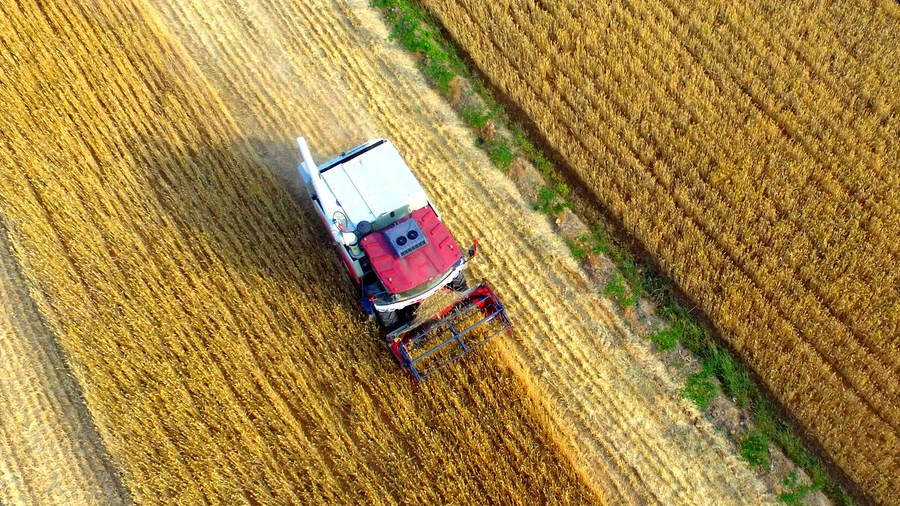
Aerial photo of farmers harvesting wheat in the fields in Xiapo Village of Linyi, east China's Shandong Province, May 24, 2022. /Xinhua
Aerial photo of farmers harvesting wheat in the fields in Xiapo Village of Linyi, east China's Shandong Province, May 24, 2022. /Xinhua
China will accelerate the creation of a new development pattern and pursue high-quality development, President Xi Jinping said Sunday at the opening session of the 20th National Congress of the Communist Party of China (CPC).
"We embraced the centenary of the Communist Party of China; we ushered in a new era of socialism with Chinese characteristics, and we eradicated absolute poverty and finished building a moderately prosperous society in all respects, thus completing the First Centenary Goal," Xi said.
As the world's largest developing country, accounting for nearly one fifth of the global population, China has eliminated poverty in entire regions and eradicated extreme poverty in February 2021. Over the past four decades, more than 850 million Chinese have risen above the poverty threshold.
According to the World Bank's International Poverty Standards, China's poverty alleviation population accounted for more than 70 percent of the global total over the same period, said a white paper released in April 2021 by the State Council Information Office.
"China's own national success in reducing poverty accounts for a very large part of the global poverty reduction over the past decades," said Fabrizio Hochschild Drummond, special adviser to UN Secretary-General Antonio Guterres on the commemoration of the 75th anniversary of the UN.
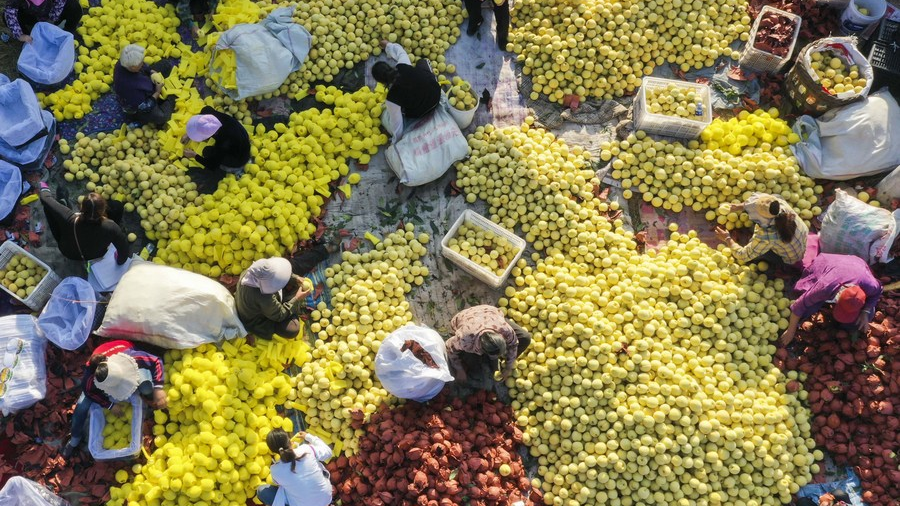
Aerial photo of villagers sorting and packaging yellow peaches in Dongjiuzhai Township of Zunhua, north China's Hebei Province, September 15, 2022 /Xinhua
Aerial photo of villagers sorting and packaging yellow peaches in Dongjiuzhai Township of Zunhua, north China's Hebei Province, September 15, 2022 /Xinhua
The way of poverty alleviation
China's approach of eliminating poverty combines government leadership and support from all social sectors with farmers playing a major role, and integrates general and special favorable policies, poverty alleviation programs and social safety nets, said Huang Chengwei, director of the National Poverty Alleviation Training and Communication Center.
Since China marched into a new era after the 18th CPC National Congress in 2012, the country reached a critical stage in building a moderately prosperous society in all respects and achieving the First Centenary Goal.
In 2013, President Xi proposed for the first time the concept of "targeted poverty alleviation" during his inspection tour to Shibadong Village in central China's Hunan Province. The notion focused on tailoring poverty alleviation efforts to different individuals and local conditions.
In November 2015, China decided to launch a campaign to eliminate absolute poverty by 2020. The CPC further specified the task of eliminating rural poverty and rehabilitating all impoverished counties.
By the end of 2019, the number of impoverished people in rural areas dropped to 5.51 million from 98.99 million in 2012, and the poverty headcount ratio reduced from 10.2 to 0.6 percent.
Faced with the sudden attack of the COVID-19 pandemic in 2020, China determined to accomplish its tasks for winning the battle against poverty and successfully met the UN's eradication target 10 years ahead of schedule. By the end of the year, all 832 impoverished counties and 128,000 villages had been removed from the poverty list.
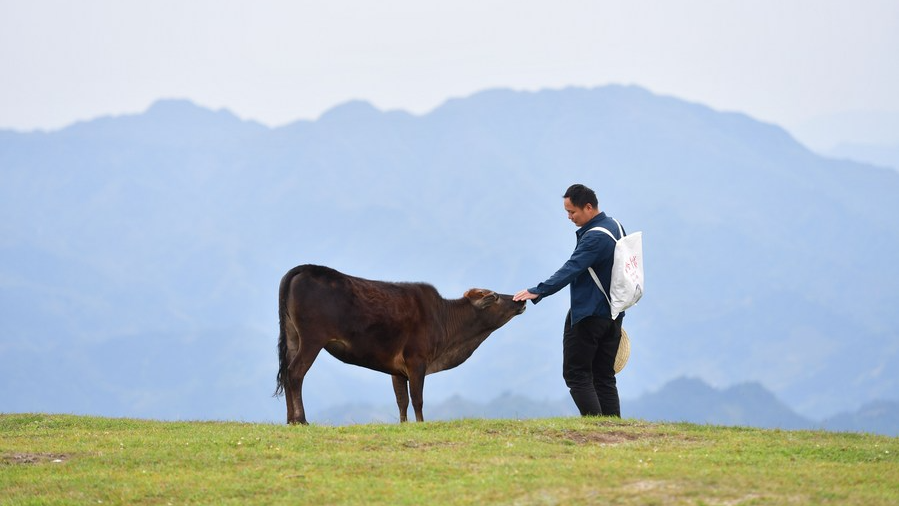
Li Yicheng, a poverty alleviation team member, learns about the growth of cattle in Yaogao Village's high mountain natural pasture in Rongshui Miao Autonomous County, south China's Guangxi Zhuang Autonomous Region, April 26, 2020. /Xinhua
Li Yicheng, a poverty alleviation team member, learns about the growth of cattle in Yaogao Village's high mountain natural pasture in Rongshui Miao Autonomous County, south China's Guangxi Zhuang Autonomous Region, April 26, 2020. /Xinhua
Strategy of targeted poverty alleviation
Through poverty alleviation, the central government aims at increasing the income and improving the welfare of the poor. It worked on realizing the Two Assurances and Three Guarantees, which refers to assurances of adequate food and clothing, and guarantees of access to compulsory education, basic medical services and safe housing for impoverished rural residents, according to the white paper by the State Council Information Office.
To carry out targeted poverty alleviation, about 800,000 officials have been sent to the frontline on poverty-relief missions, working on the very local level. The government encouraged sci-tech experts to go to poor areas to provide intellectual support and promote entrepreneurship, and innovation platforms have been established to allocate scientific and technological resources to poor areas.
While attending the deliberation session of the Guizhou delegation at the Second Plenary Session of the 12th National People's Congress in 2014, Xi stated that "inspection tours must be conducted to identify the truly poor. Poverty alleviation must reach those who truly need it, and poverty must be fully eliminated."
President Xi has made domestic trips with poverty relief high on the agenda. He has visited every one of the 14 contiguous poor areas across the country and over 20 poor villages, listening to impoverished households about their difficulties and needs. He also visited the cultivated fields and homes of the farmers to learn about their stories of getting rid of poverty.
"Being lifted out of poverty is not an end in itself but the starting point of a new life and a new pursuit," Xi said during his trip to southwest China's Yunnan Province.
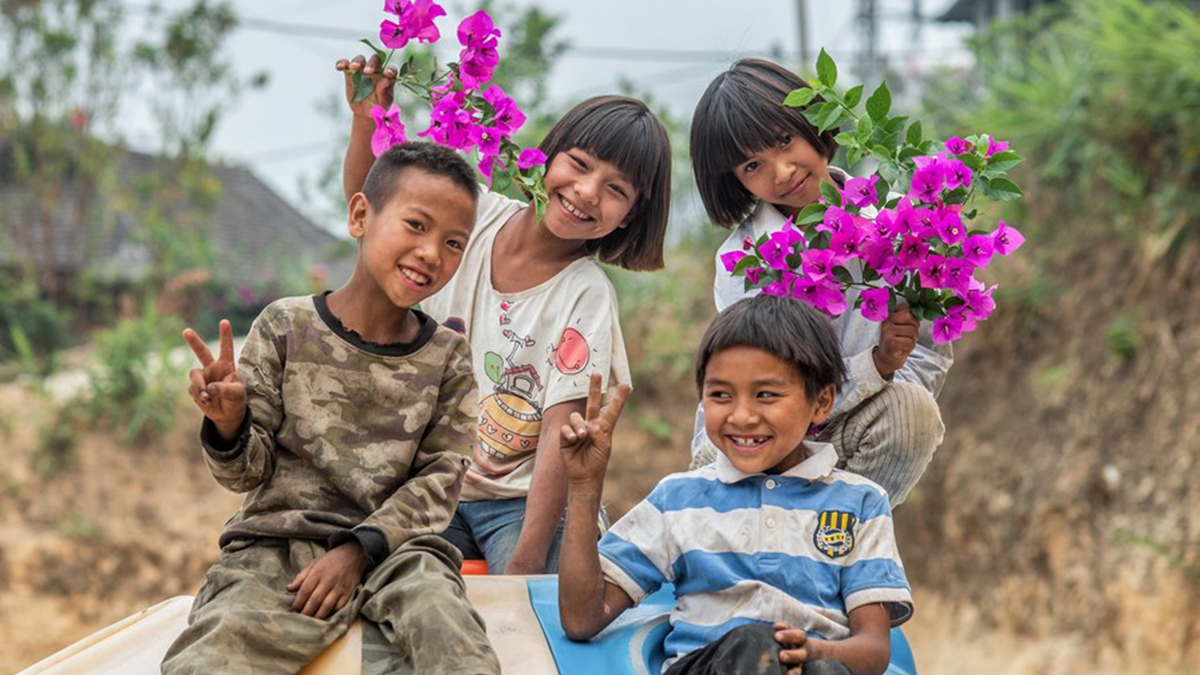
Kids of the Lahu ethnic group pose for a photo in a hamlet of Bulangshan Township in Menghai County, southwest China's Yunnan Province, April 9, 2020. /Xinhua
Kids of the Lahu ethnic group pose for a photo in a hamlet of Bulangshan Township in Menghai County, southwest China's Yunnan Province, April 9, 2020. /Xinhua
From poverty alleviation to rural revitalization
With continuous efforts by the CPC, rural infrastructure, education and health-care all improved. As of 2020, telemedicine has covered all county-level hospitals in poverty-stricken counties, according to the State Council.
Abuluoha Village in Butuo County, located in southwest China's Sichuan Province, is among the areas that benefited from the improvement in rural infrastructure. The village nestles in a mountainous area and is connected to the outside world by a rugged trail built along a cliff. Villagers had to take about four hours on foot if they want to go out of the village in the past. In 2020, a 3.8-kilometer road connecting Abuluoha to other villages in the county was built.
Read more: https://news.cgtn.com/news/2020-05-31/7-months-left-how-can-all-Chinese-counties-shake-off-poverty--QVPvWlvbqM/index.html
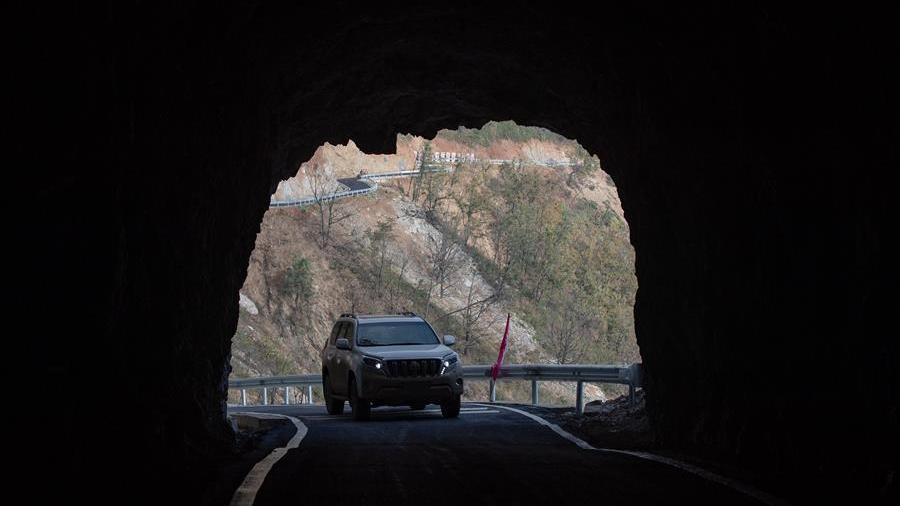
A vehicle runs on a completed section of the road at Abuluoha Village in Butuo County of Liangshan Yi Autonomous Prefecture, southwest China's Sichuan Province, December 29, 2019. /Xinhua
A vehicle runs on a completed section of the road at Abuluoha Village in Butuo County of Liangshan Yi Autonomous Prefecture, southwest China's Sichuan Province, December 29, 2019. /Xinhua
Efforts were also made to bolster the construction of logistic infrastructure and smoothing channels to promote the sale of farm produce. In March 2020, the Ministry of Agriculture and Rural Affairs' development planning department rolled out plans to organize several trade fairs for the poorest areas. Farmers did not need to pay fees to rent the exhibition booths.
Communications infrastructure has been extended in poverty-stricken areas, as over 98 percent of poor villages have access to optical fiber communications and 4G technology.
During the COVID-19 pandemic, e-commerce has played an important role in alleviating poverty. Online retail sales increased 26 percent year-on-year to a total of 301.45 billion yuan (about $41.85 billion) across China's 832 national-level poverty-stricken counties in 2020.
After eliminating absolute poverty, the Chinese government is now prioritizing rural revitalization.
To advance rural revitalization across the board, China will continue to put agricultural and rural development first, consolidate and expand achievements in poverty alleviation, and reinforce the foundations for food security on all fronts, Xi said at the opening session of the 20th National Congress of the CPC.
(With input from Xinhua)
(Cover: Poverty relief assistants and village officers help carry melons planted by villagers in Dongqin Village, Congjiang County of southwest China's Guizhou Province, Nov. 11, 2020. /Xinhua)